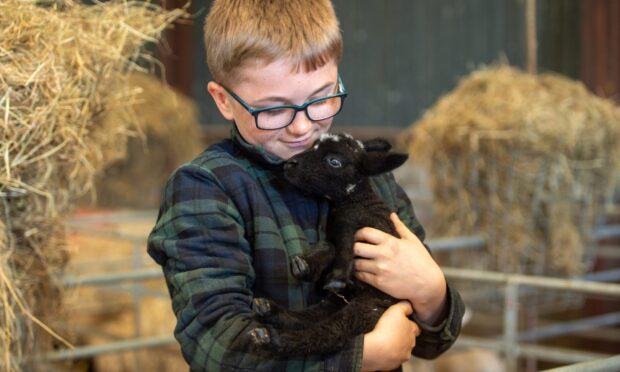Moving with the times and never forgetting his Dundee roots, the oldest 10-year-old in Beanotown has been inspiring mini-menaces for generations. We take a look at Dennis’s enduring appeal.
For many Beano fans, the comic strip simply wouldn’t be the same without the infectious irreverence of Dennis the Menace. In fact, the wild-haired prankster didn’t feature until 1951, as head of Beano Studios, Mike Stirling explains: “At first, the majority of the characters in The Beano were adults and it was the introduction of Dennis 70 years ago that offered children a character they could really identify with.”
Mike firmly believes that Dennis is a character who could only have been created in Dundee.
“When the Beano came into being in 1938, it was very different to the comics that had gone before it,” he explains. “Dundee is a city that has a unique history of rebellious kids.”
These kids were the children of the women who went out to work in the jute mills. The working women fought hard to gain better working conditions.
“There was so much industrial action,” says Mike. “Between 1890 and 1910 there were over 100 strikes in one Dundee factory alone. The kids were politicised by their mums, they could read and Dundee also became the place with the highest level of school strikes.”
Those kids who grew up embracing the rebellious undercurrent are the same people who grew up to become the artists and writers who worked in the DC Thomson Fun Factory.
According to Mike, the legend that Dennis was first drawn on the back of a cigarette packet is true, and that first drawing still exists.
“George Moonie and Davy Law were struggling to sort out the idea for a new character,” explains Mike, “so they left Dundee and went off to lunch in St Michael’s in Fife, where the first drawing was done!”
The first ever Dennis strip featured him wearing a shirt and tie while accompanying his dad on a walk in the park. He didn’t gain his cheeky canine companion until 1968.
“Gnasher was first conceived by Ian ‘Smoky’ Grey. He was a great dog lover and was keen to give Dennis a pet, so he took Dennis’s hair and added on teeth and eyes and four legs! Later, David Sutherland really developed Gnasher into a wildly funny creature.”
A character whose antics outlast the careers of those who draw him means that he has been brought to life by different artists. At first, explains Mike, the new incumbent spends time learning to draw in the style of the existing character, “but then gradually you can see the influence of the artist and changing times developing through the drawings. You see Dennis in 1951 when he starts out quite stocky and then elongates over the years.”

His irreverence and dogged desire to challenge authority figures endures but the Dennis the Menace of the early 1950s was as relevant to the children of that generation as Dennis and Gnasher are to kids in 2021.
Beano editor John Anderson explains his lasting draw for young readers: “Dennis’s adaptation is baked into the format and part of his appeal. His stories are told from his point of view – the point of view of a 10-year-old boy. As the lived experience of 10-year-olds has changed, so too has Dennis tracked those changes.
“Dennis’s history in the comic is not just a story of mischief and fun, but a story of constant, gentle reinvention to reflect the lived experience of children over the last 70 years. He would not have been half as successful without it, and it’s a credit to writers, artists and editors past and present that they’ve understood and encouraged it.
“Dennis was Beano’s first real audience point of view character. He’s both a hero in the original meaning of the word as the lead character in his own comic strip, and a hero in the more modern meaning too, as a character that readers admire and also aspire to be like.
“He’s creative, adventurous, brave and fun to spend time with. He responds to obstacles and pointless authority in the way we would all like to before adulthood makes us all self-conscious and a bit embarrassed.”
That ability to have a finger on the pulse of how kids think is thanks to the behind-the-scenes work of The Beano Brain and the idea that the comic belongs to its readers.
“We speak to the kids all the time,” says Mike. Writers started out by seeing what their own kids were doing but now the team gathers the opinions of kids and trendspotters across Britain and Ireland every week. Mike’s favourite example of reader involvement is when the editor invites a fan to be the Beano Boss.
“It’s a superfan who knows all the characters as well as we do. We have always said that all our best ideas come from our readers. It can be stressful, though, the Beano Boss could come in at the last minute and say ‘that’s not funny’ and the idea would have to go!”
Dennis and pals are now accessible to more children than ever via the CGI animation Dennis & Gnasher Unleashed and to anyone with an internet connection via Beano.com.
Vanessa Andreis is director of franchise planning at Beano Studios: “The characters have travelled incredibly well, not only in the English-speaking territories where there is an inherent awareness of Dennis and Gnasher, but all over the globe,” she says.
“You can now watch Dennis in more than 300 countries worldwide, from Germany to Singapore. Dennis’s funny mischief has attracted a global fanbase and we want to enable fans to connect with him through publishing and merchandise to gaming and experiential.”
Rather than being the demise of the printed comic, Mike reveals that these new platforms “bring in readers who might not have come across the comic otherwise and The Beano has gone up in sales every year for four years now.”
Dennis has been part and parcel of growing up and learning to love reading for children all over Britain and Ireland. Robbie Dalrymple, age 12, who lives in St Andrews, remembers coming across the comic for the first time at school.
“My teacher Miss Baird brought the comics into school for the whole class because she had a subscription and she thought we would like them,” he says.
Robbie’s mum Donna Grieve explains that Miss Baird, who has since sadly since passed away, saw the comic as a great way to promote reading for fun.
“She would quite often send a note home to say that there was a deal for a Beano subscription – she knew it was a good way to encourage him to read,” she says.
Dennis’s mischief was a big attraction for Robbie: “They always play pranks on people and it’s quite funny. Every week they have a cool story.” Robbie remembers that “there was a stink bomb and itching powder one, they put itching powder down his dad!” Despite the fact that the character has been around for a long time, Robbie says that he doesn’t seem old-fashioned or stuck in the past. “He is kind of like a 10-year-old boy today,” he says.
Cellardyke-based Elise Methven, 49, and her daughter Ruby, 15, share a love of Dennis and Gnasher. “I remember first reading The Beano when I was about nine,” says Elise. “Up until then, I had been a Bunty fan and my brother always got the Victor comic, which appealed to my sense of adventure. The Beano was a lot cooler in my mind!”
Like many children, she had a subscription and her comic arrived with the paper delivery. “I used to get so excited on the day it was arriving,” she recalls. “Dennis and Minnie the Minx were the main characters for me. Dennis was cheeky and daring – something I really wasn’t. Looking back, he was quite the extrovert. I liked the fact he wasn’t scared and was always up for a joke or a prank.”
For Elise, “Dennis is only half the menace without Gnasher. Gnasher sticks by him through everything – even the most foolhardy of schemes. I liked the way Gnasher was drawn – although he didn’t say anything, the looks he was given gave a really good idea about what he thought of some of the schemes.”
Ruby Methven remembers the first time she picked up a Beano. “When I was in Morrisons I got bored listening to my mum’s adult chat, so she told me to go get something from the magazine section to read,” she explains. “I was about eight.” Dennis was a favourite. “I wanted to be like him. I thought he was cool because he didn’t listen to the rules. I loved Gnasher and used to pretend our border terrier Otto was my sidekick.”
With the development of Dennis into a TV character and the Beano’s online presence, you might be forgiven for thinking that the print comic might be left behind. Mike Stirling is adamant that won’t be the case. “We still sell a copy every seven seconds in the UK,” he points out. “First and foremost, we love to show kids that reading is fun. We know how lucky we are to be connected with such a cool thing.
“I think Dennis is going to endure,” he says. “He changes incrementally every week. The format of the paper comic has had a renaissance. The Beano makes us feel good.”













